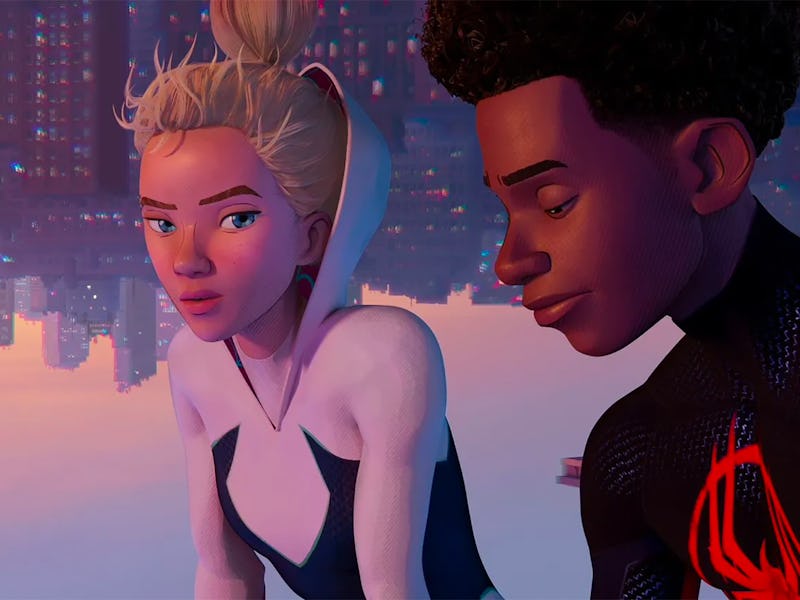Netflix Just Released the Best Sci-Fi Superhero Movie of 2023
Across the Spider-Verse is just as beautifully crafted as its predecessor — and twice as ambitious.

The multiverse is everywhere right now, but few stories have explored the concept with the enthusiasm and artistry of Spider-Man: Into the Spider-Verse. The 2018 film’s success was three-fold: not only did it explore a new corner of Spider-Man’s world (a feat Sony has been trying to pull off in live-action for years), but it revolutionized the world of animation, and entered the multiverse with an uncanny blend of maximalism and focus. Lest we forget, it’s also an Oscar winner.
It took five years for Miles Morales (Shameik Moore) and his crew of Spider-People to return in Across the Spider-Verse, but the sequel was worth the wait. It’s as much in conversation with its predecessor as with the slew of multiverse movies that have come out since.
Since Into the Spider-Verse burst onto the scene, parallel worlds have become Hollywood’s latest fixation... and one of the hardest plot points to really get right. So what keeps the Spider-Verse films from slipping into the same mistakes? Is it their central heroes, or their pitch-perfect interpretation of the Spider-World, which is filled with equal parts superhero drama, coming-of-age angst, and classic tragedy? That’s part of it, but these films also push the boundary of what’s possible on screen. In the spider-verse, spectacle is just as important as story.
Into the Spider-Verse set its visual bar sky-high, but its sequel doesn’t hesitate to pick up the gauntlet. From the first frames of its glitchy title sequence, Across the Spider-Verse swings head-first into even more ambitious territory. The story of Spider-Man is one that’s been told time and again; the first Spider-Verse film shook things up by telling it from Miles’ perspective, and Across makes another shakeup. Gwen Stacy (Hailee Steinfeld), aka Spider-Gwen, is a co-protagonist now; her impressionistic, hyper-saturated world opens the film, and while it’s a far cry from the design of Miles’ own realm, it’s just as visually stunning.
We catch the highlights of Miles’ ascension to Spider-Man through Gwen’s eyes. He was bitten by a radioactive spider, and he’s been through a lot since, but he’s not the only one. That shared experience is the backbone of Sony’s animated Spidey films. Here, anyone can be Spider-Man, whether you’re a 15-year-old kid from Brooklyn, a blondie in ballet flats, or an aging wall-crawler trying to keep his family together. Across the Spider-Verse introduces us to many, many more Spider-People, but as the roster gets bigger, it becomes less of a question of who is chosen to answer the call, and why they’re chosen in the first place.
An early focus on Gwen — and her distinct world — expands Across’ already epic scope.
It’s since become a meme, but the existence of the Spider-Verse actually hinges on something called a “canon event.” These are the shared tragedies that connect Miles to Peter Parker (Jake Johnson), and Peter to other variants. It’s what makes someone Spider-Man, and what keeps the multiverse, with all its unwieldy timelines, running smoothly. At least that’s what Miguel O’Hara (Oscar Isaac), leader of the Spider Society, believes. He’s tampered with enough canon events to see the destruction it wreaks, so he’s dedicated his life to forming a multiversal police force.
Miles in particular is overdue for an unalterable canon event, and his efforts to prevent it will make him an enemy of Miguel and the Society. It’s here, in this thorny conflict, that Across starts to lose a bit of its footing. Tough questions about fate and loss will always give films plenty to explore, but it gives Across a bit too much to chew on, at least over 140 minutes. It’s half of a two-part story — Beyond the Spider-Verse will close this chapter in 2025 — but Across’ cliffhanger leaves a lot to be desired.
The movie has a whole lot to set up, and it does so with a deft hand. It can be frustrating to follow the story knowing there will be a two-year wait for a clear resolution, but the spectacle within still makes it worth your time. Miles’ odyssey through the Spider-Verse is thrilling, and the disparate techniques used to breathe life into a host of new Spideys speak to the behind-the-scenes craft. The animators and effects artists who made the film deserve their flowers, especially after the behind-the-scenes tumult they endured. Across’ story may not be as tight or focused as its predecessor, but it can’t be faulted for taking such huge risks, especially when the end product looks as good as it does.